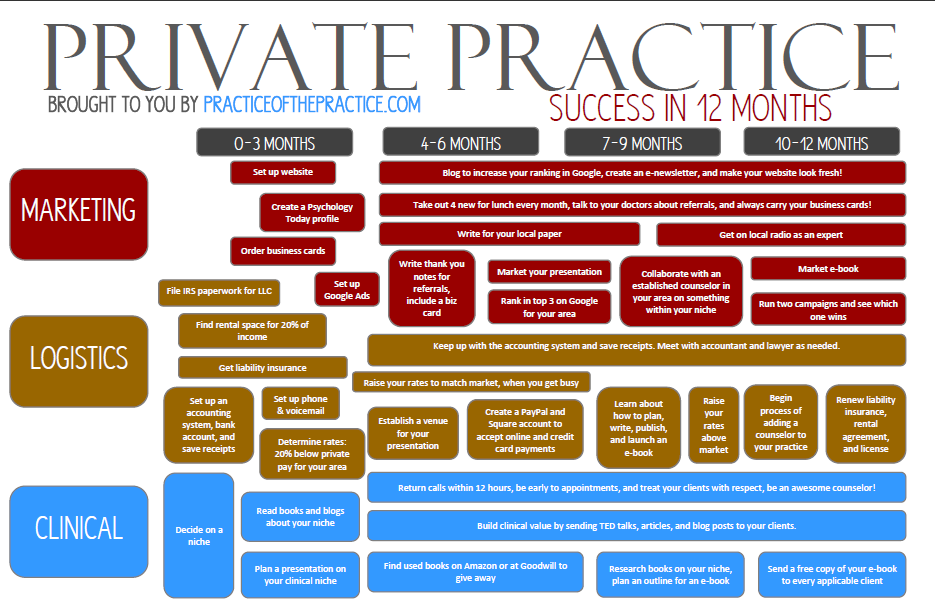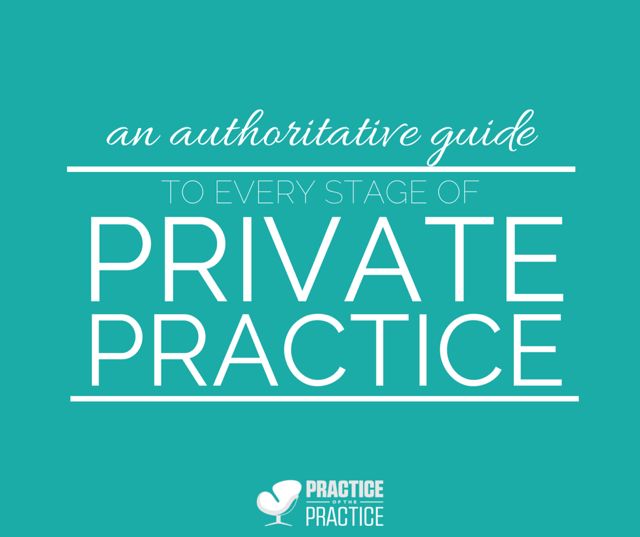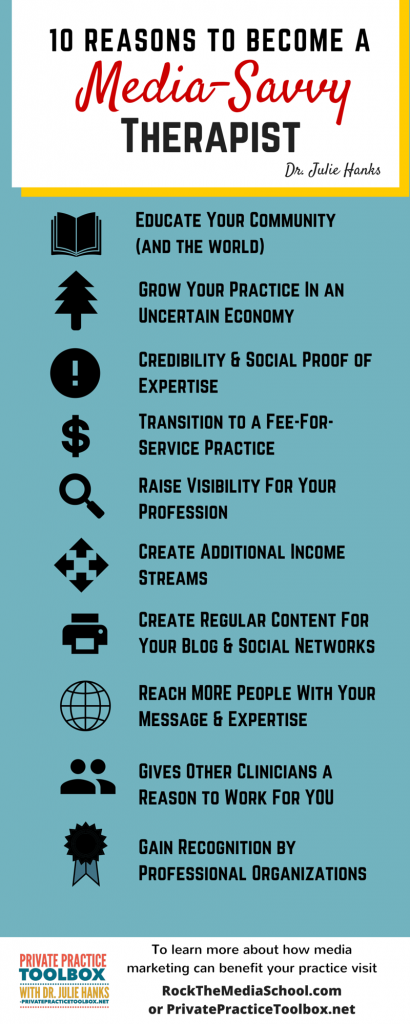At every stage of private practice you can grow. When you are starting a private practice, the main focus is on launching and getting clients. Once a private practice is established, the main focus is on systems and scaling a private practice. Once a private practice is thriving, growing income through consulting and products is the next step.
This article will help you:
- Determine what stage of private practice you are in
- Have a clear plan for every stage of private practice
- Know what is coming and how to grow income and influence
Phase 1 | Starting a Private Practice
Name your private practice: Naming a private practice can be tough. Do you name it your name or something else? Quick tip: Don’t name it your name, so if you ever want to sell it, it is easier.
Buy a URL: A URL is the www. [your practice] .com, a .com is always preferred. When you name a private practice, make sure you can get the same URL as your name. I use Namecheap for my domains.
Make sure you are licensed correctly in your state: You should know how to do this. If you’re in Michigan, here’s my step-by-step process for filing to become a LLPC in Michigan. You’ll need LLPC supervision in Michigan too. Outside of Michigan, check out your own state’s requirements.
Create a plan: Creating a quarter-by-quarter plan will keep you on track to meet your first year goals. Here’s an example:Launch a private practice infographic .
.
Get liability insurance: You’ll want at least $1m/$3m coverage. I use HPSO, but I’ve been hearing that they have not been reimbursing all legal payments like they should. I’ll let you know if I hear more.
Create a website: Creating a counseling website is one of the first things you want to do. There are a number of ways to do this:
- Build your own counseling website.
- Rent a website through TherapySites or BrighterVision
- Have one built (I’ve used Legendary Lion).
- If you do it yourself, Bluehost has a number of videos to help you set up a website through WordPress.
Get rid of that email: Want to look like you’re brand new, then keep that aol, yahoo, or gmail account for professional use. Instead, set up a new professional gmail and use the alias feature to have your name @ your domain . com
Set up your legal structure: I had an accounting friend help me, but recently my wife used LegalZoom. She filed her PLLC in about 15 minutes. Usually a PLLC is best, but consult a local attorney or accountant if you aren’t sure.
Find a bank for your private practice: After your business is legal, get a separate bank account for the business and keep all receipts that have to do with the business.
Have private practice paperwork: Make sure you have your intake, progress notes, informed consent, and HIPAA forms in order. Here’s some private practice paperwork for you.
Identify a specialty: So help me, if you say, “I do individual, couples, and family therapy” or “I see everyone” I’m going to freak out on you. Stop saying that, it means nothing! imagine your kid was dealing with angry outbursts, would you see a counselor that “sees everyone” or someone who says “I help angry kids.”
Rent private practice space: When you’re first starting out, keep your costs low, I mean dirt cheap low. The best way to do this, is to sub-lease from an established practice. You can offer to give 10-20% of your gross income in exchange for using the office. Another option is to pay per day. For example, you might say, “I can pay $50 per day for exclusive use of the office on Tuesdays.”
Learn to be media savvy: Engage the media using Help a Reporter Out. Private practice owner, Julie Hanks says in her article 10 Reasons to Become a Media-Savvy Therapist, “This decision to become media-savvy has altered the course of my professional life in exciting and new ways”
To request an invitation to her RockTheMediaSchool.com Fall Cohort.
Start an e-mail list: An email list is one of the best ways to connect with readers, potential clients, and non-local clients in the future. Say your niche is angry kids. You may have an email list that offers a PDF of “7 Quick Tips to Reduce Your Child’s Anger.” Then create an automated email sequence that sends an email 1-2x per month with a tip for that population. You don’t want to be sales-pitchy just offer great content.
Get a logo created: A nice looking logo an go a long way! Very few private practice owners have a quality logo and website. Doing this step alone will put you in the top 5-10% of private practices. A few resources for logo design are: 99Designs, Fiverr, and your own network. Unless you have a design background, don’t do this yourself!
Buy lunch for someone: After you determine your specialty, find 10 people that are doing what you want to do. Offer to buy each of them lunch to pick their brains about the ups and downs of private practice. Here’s an example email:
“Good afternoon, ____________, I was reading through your website and I see that you help angry kids. I love your video about what to do in tough situations. I’d love to pick your brain about the ups and downs of private practice. Also, it will help me know who to refer to you as those opportunities come up. I’d love to buy you lunch sometime.”
Focus on one social media: Which social media are you already on? Do you love Facebook? Pinterest? Instagram? Start where you are already connected and learn a ton. Don’t be sales pitchy, instead, create content that mirrors your specialty.
Evaluate your cancelation policy: Private practice consultant, Evan Center, says, “…it occurred to me that the standard 24-hour cancellation policy most therapists have has no connection to anything therapeutic OR business-focused.” What will yours be?
Set up your private practice phone system: Landlines can be crazy expensive. I use Grasshopper for our lines, but there are tons of options that use your cell phone. I don’t think Google Voice is professional enough to use.
Determine if you are going to take insurance: This is not a lifelong decision. There are many ways to add or leave insurance. Each has its benefits. Taking insurance opens an immediate market. As well, it is much more convenient for the average person. However, focusing on private pay will reduce your paperwork, increase your ability to make more income over time, and reduce stress.
Order business cards: Since you now have a sweet logo, put it on your business cards. There are cheap ones, but this is another area of investment that tends to portray a strong professional image. I personally use Moo because they are beautiful and hip.
Schedule a few community talks: Now that you have a specialty, find partners that have an audience. These could be local non-profit organizations, United Way, or schools. These places can promote a free talk to their audience.
Evaluate Electronic Medical Records Systems: Rob Reinhardt from Tame Your Practice has a great review of numerous cloud-based practice management systems. He says: “Even when you have narrowed the field, there are so many factors to consider, it can be very difficult to make a final choice. Very rarely will readers find that one of the solutions meets every single one of their needs. In most cases, you will need to prioritize the features most important to you and choose the one that fits most of them, perhaps with a leaning toward those most likely to add the missing features.”
Set up a payment system: I use Square for my private practice. Yes, credit card companies take 2-3% however, think about the math. If every 33 times you get a payment that you would have lost because of forgetting their checkbook, not scheduling because of non-payment, or some other reason. I use Square.
Start blogging: Within your website, blogging is the single best way to start ranking in Google. Also, it build authority and expertise. In doing this, you are creating a stronger value proposition. Potential clients will see you as being more valuable than some name on a list approved by insurance. Also, it helps with SEO (Search Engine Optimization aka how well you rank in Google).The more value you bring, the more influence and income you can achieve.
Bonus
- Optimize your website: After you have completed everything above, go through your website and optimize it for keywords. Ideally you want [your city] + [your niche] or [your city] + counseling/therapy/counselor.
- Become an Amazon Associate: Amazon will pay you 3-10% for sales of items when you refer people. Most counselors have their favorite books. If you’re recommending books, make them links through Amazon and you’ll get a percentage of everything someone buys for 24 hours after clicking your link!
- Listen to Private Practice Consultant Allison Puryear: Go through a checklist before you ever see your first client. Here’s a link to get her Before You See Your First Private Practice Client Checklist and article.
- Listen to Private Practice Consultant Kelly Higdon from ZynnyMe: She says, “Everyone needs to continue to build their message. The message is what connects them to their ideal client and identifies their value as a therapist.” Get free access to their free mini-courses!
Phase 2 | Growing a Private Practice
Automate the private practice: Look for ways to outsource what you do. What takes up time and could be done cheaper by someone else? Cleaning, bookkeeping, and answering phones are some quick examples. Learn more about how to hire virtual assistants.
Raise your rates: Most counselors are undercharging for what they offer. Plumbers, electricians, and dishwasher repairmen often make more than $100 per hour. What is helping a family reconnect worth? If you already have clinicians, this establishes you at the premier person in a premier practice.
Have a higher intake fee: Forget offering a free 15 minute consult, go the opposite direction. It takes more time on the front end and it also helps you test your higher rates. Typically, if someone is willing to pay the price for your intake, the session fee can be close to that fee.
Grow your expertise: As your practice grows, your expertise and value offering has to grow as well. This can be done in a number of ways: write a book, do more community seminars, or serve on a board of directors.
Learn how to use keywords for your blogging: Google has a free keyword planner tool. You can determine exactly how frequently specific terms are Googled in your area. Here’s a video on how to do it:
Review your liability insurance: If you are teaching, consulting, or have additional clinicians, make sure you are covered for the business and your own clinical work.
Write a book: It sounds hard. I’m sure you’re like, “Joe, writing a book is difficult, you can’t just put it as a point in a blog post!” But actually, it’s quite easy if you do it correctly. Think of a book as a list of lists. Let’s go back to the “angry kids” example:
- By this stage in your practice, you’ve probably written a blog post a week for two years or so.
- That should be 100+ blog posts. If each is 500 words, that means that you already have 50,000 words.
- That’s a book that is roughly 180-220 pages! It’s just a matter of categorizing the blog posts into subjects.
- As well, you just want the flow to feel like a book that is progressing, not a hodgepodge of blog posts.
- Creating an e-book for Amazon is super easy!
Plan a book launch: A book launch at a small independent bookstore is a great way to get free promotion. Also, it’s a great hook to get on local radio and have the local newspaper talk about your practice. I had a band and free wine at mine. It was a great excuse for a party to promote my practice and showed that I am fun too!
Give your book away: Depending on the length of your book, you can self publish with Amazon for around $2 per book. It’s like a huge business card. Imagine your rates are $150 per session and people come an average of 5 sessions. That means a new client is “worth” $750. Do you think that you’ll get a new client every 375 times you give a book away? Of course, be strategic, give them to doctors, lawyers, or pastors. Tell them, “It is selling at the local bookstore for $14.95, but here are a few to help your clients.”
Give your book away at your intake session: Capture your best work in your book. Tell new clients, “This will fast forward what we can do in counseling. If you read this, it will save you time and money.” I have had numerous new clients say, “I knew you were worth the money.” By adding genuine value, it increases your influence and income!
Add clinicians: In some states it’s advised to add counselors as W-2 employees. From talking with people in California and Utah, W-2 is almost always advised. In other states, I prefer to have a 1099 contractor. Either way, having a commission-based payment is advised. I do 50% of what is brought in for the first $1,000 and then they get 65% after that. You may structure it differently.
Know how to explain why they should work for/with you: Why should someone give up 50% of the income they bring in? So many business owners ask me this. Let’s think about this a little deeper:
- How much does that average non-profit pay counselors in your town? In my town it’s usually $15-$25 as a new graduate and $25-$35 for supervisors, who we all know work way more than 40 hours!
- If your clinicians are charging $120 and you take 50%, right away folks are making $60 per hour. 40 hours per week x $20 per hour is $800. That would be only 14 sessions in your practice.
- Also, they don’t have to pay rent, deal with owning a business, take on the liability of renting, or worry about marketing.
- When someone wants to “dip their toes” into the world of private practice, this structure is especially appealing.
- Also, if someone thinks they may move eventually, being a counselor for someone else’s private practice is especially wise.
Create systems: At this time of this writing, I have 7 clinicians at Mental Wellness Counseling. At clinician 5 I realized that adding people took a lot of thought, so I created a checklist of everything to cover. At clinician 6, I realized I forgot some things. Eventually, I’m going to have my virtual assistant do most of the on-boarding process. By creating systems, it helps your brain to focus its energy on the tasks it needs to use the energy.
Reinvest in branding: My first website was really ugly. Then I upgraded to WordPress and Bluehost, it was alright. In 2014, I paid someone to do a full update. I waited to invest until it made sense. You may invest right at the beginning. Either way, updating branding, rack cards, office furniture, or adding a refrigerator, all builds your professional appeal.
Hire before you are ready: When you bring on a contractor or employee, don’t wait until you are full. Each new clinician brings their own network, energy, and skill set. They’re going to market themselves and you’re going to market the practice. When you are half as full as you want to be, that’s the time to start bringing people on.
Create opportunities: As the business owner, you want to continue to transition toward working on the business instead of in it. So, you should be out there, talking to your own doctor, pastor, and network to create opportunities for your clinicians to tell their stories. I try to have at least one meet and greet per month, where we go to a new referral source’s office to learn about them. They always ask how we can build a referral relationship.
Take time for yourself: For years I have had Saturday as a no email, business, or social media day. The only exception is that I can listen to podcasts while I mow the lawn or blow snow. Also, if I’m up before the girls, I sometimes drink coffee and read a business book. This summer, I am scheduling every Friday off as well. I may do a little bit of social media, but probably not much. You are your biggest asset, keep that tool ready to go!
Exercise: This has been a struggle for me. In January 2015, I was hospitalized again for my lower back pain. I had a bulging disk that broke off and landed on a nerve. My core is not strong. I have learned that if I don’t exercise, I’ll be back in the hospital. If we think about our bodies as a tool, we’ve got to keep them in their prime.
Sleep: It’s easy to cut out sleep when your business grows. However, to be in your prime, you probably know that being sleep-deprived won’t help. I get 8-9 hours per night.
Get a really good handle on your finances: If you don’t have a CPA, it’s probably time. A CPA will help you optimize your tax situation and provide the structure and peace of mind.
Get a re-evaluation of your legal risks: You need a legal go-to person. This person will help review your contracts with employees/contractors, reduce lawsuit risks, and help scale in the future.
Find a mentor or consultant: This is probably a good idea when you’re first starting out as well. When you’re first starting, you’re usually bootstrapping, but once you are established it’s essential to have a mentor or private practice consultant.
This doesn’t have to be someone you pay. This is just someone at a level where you want to be. It can be a collection of advanced professionals. I have numerous people I bounce ideas off of.
These can be formal private practice consulting relationships or informal. Most people would be honored for you to ask to pick their brain in exchange for a lunch every few months.
Bonus
- Increase dialog with your email list: After your first automated email after an individual signs up for your email (it is automated right?) have an email that goes out a few hours or a day later. This email should not be formatted at all, no logo, more like writing a friend. Write something like:
“Hey [name], Yesterday I sent you my PDF ‘7 Social Media Traps Parents Don’t Know.’ I just want to make sure you got it. Will you just reply: yup, got it, sure thing, or something like that? -Joe” This increases dialog with your list and also moves you from the promotion section of gmail to the inbox! - Start exploring an e-product: Now that you’re engaging with your audience, an e-course around a niche is a great way to grow passive income. Imagine you have built an email list since you started. You have a few thousand parent’s emails. Maybe you’ve focused on information that helps them with their middle schooler. Let’s do some math: 2,000 people on your list and 5% purchase your product = 100 people. Charge $295 for a video e-course, a Q/A monthly call for 4 months, and a private Facebook Group. That’s a $29,500 day!
Phase 3 | How to Become a Consultant
There’s a reason that I started the How to Become a Consultant Podcast. It’s a natural next step after you have success. After I help you start a private practice, I want to help you grow a private practice. After you are successful there, consulting is a phenomenal way to increase income and influence.
Grow your specialty: There are three major directions that you can take in building a consulting specialty. You can always have a mixture.
- Start consulting on what you’ve been doing: For example, Dr. Julie Hanks is amazing at getting the attention of the media. She’s been featured in The Wall Street Journal, CNN, TLC, Fox News, Cosmopolitan, and HuffPostLive, just to name a few. As a clinician, she was in the media all the time! So what did Julie do? She launched her own course, to request an invitation to her RockTheMediaSchool.com Fall Cohort click the link. It’s a course that teaches counselors how to rock the media, which was her area of specialization!
- Use skills with a company, non-profit, or organization: Imagine you have a background in crisis management. This skill is transferable to banks, businesses, and firefighters. There’s a ton of applications!
- Create a product: Use your skills to create a product that explains one of the two above types of specialties.
Grow an audience: Once you have established a specialty, you can grow an audience. I was recently talking with someone from my How to Become a Consultant email list that was interested in teaching private practice owners how to take insurance. I encouraged her to start blogging and sharing information so that her audience could have major value. In doing this, she would also be demonstrating her expertise.
Grow an income: Once you have a clear specialty and have built an audience, it’s easy to grow an income. Earlier we discussed counseling e-products. The same is true for consulting. Even more, the hourly rate can be significant.
- If you’re already making $150-$200 per session in private practice, how much is it worth to teach someone to do that? Or if you help a bank avoid a lawsuit, what’s that worth?
- One way to figure it out is this formula: How much time will I save this person multiplied by their hourly. Imagine you teach a private practice owner how to take insurance. That 45 minutes may have taken them 5 hours to figure it out. If they are billing $125, then 5 x $125 = your 45 minutes is worth $625.
- You may not charge that, but it gives a range.
Final Thoughts
What did I miss? Your comments below will truly make this an authoritative guide! Where are you at: Just starting a private practice, Growing a private practice, or Consulting? Give your very best advice below.
Joseph R. Sanok, MA, LLP, LPC, NCC
 Joe Sanok is an ambitious results expert. He is a private practice business consultant and counselor that helps small businesses and counselors in private practice to increase revenue and have more fun! He helps owners with website design, vision, growth, and using their time to create income through being a private practice consultant.
Joe Sanok is an ambitious results expert. He is a private practice business consultant and counselor that helps small businesses and counselors in private practice to increase revenue and have more fun! He helps owners with website design, vision, growth, and using their time to create income through being a private practice consultant.
Joe was frustrated with his lack of business and marketing skills when he left graduate school. He loved helping people through counseling, but felt that often people couldn’t find him. Over the past few years he has grown his skills, income, and ability to lead others, while still maintaining an active private practice in Traverse City, MI.
To link to Joe’s Google+ .


